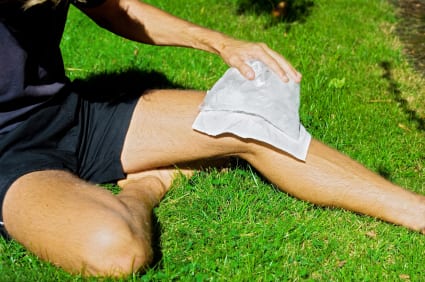As an orthopedic specialist with years of experience treating knee injuries, I often get asked, “How long should I ice my knee?” Whether you’re dealing with a sports injury, post-surgical swelling, or just general knee pain, understanding the proper use of ice therapy can make a big difference in your recovery.
The Importance of Icing the Knee

Ice therapy, or cryotherapy, is one of the simplest and most effective ways to reduce pain and inflammation in the knee. It works by constricting blood vessels, which helps to minimize swelling and numb the area, providing relief from discomfort.
I often recommend icing to patients who have experienced:
- Acute injuries (like sprains, strains, or impact injuries)
- Post-surgical swelling (after knee surgery or arthroscopy)
- Overuse injuries (such as runner’s knee or tendonitis)
- Arthritis flare-ups
One of my patients, a 32-year-old runner, had persistent knee pain due to patellar tendonitis. He tried different treatments, but nothing seemed to work until he committed to a structured icing routine. Within a few weeks, his pain significantly reduced, allowing him to get back to his training schedule.
How Long to Ice Your Knee?
The golden rule I always share with my patients is: Ice your knee for 15-20 minutes at a time, every 2-3 hours.
Here’s why:
- Less than 10 minutes: Not effective enough to penetrate deep tissue and reduce inflammation.
- More than 30 minutes: Risk of damaging the skin and underlying tissues due to frostbite.
I remember a patient who left an ice pack on his knee for almost an hour, thinking it would speed up his recovery. Instead, he ended up with mild frostbite, which delayed his healing. Always use ice properly to avoid such complications!
Best Practices for Icing Your Knee
Over the years, I’ve developed some practical tips for my patients to get the most out of ice therapy:
- Use a barrier: Never apply ice directly to the skin—wrap it in a thin towel to prevent frostbite.
- Keep it elevated: Elevating the knee while icing helps reduce swelling faster.
- Stick to a schedule: Ice at regular intervals, especially in the first 48 hours after an injury.
- Combine with rest and compression: Using the RICE method (Rest, Ice, Compression, Elevation) enhances recovery.
When to Stop Icing and Switch to Heat?
Patients often ask me, “Should I keep icing my knee after a few days?” The answer depends on your condition.
- For acute injuries (first 48 hours): Stick to icing to control swelling.
- After 48 hours: If swelling reduces but stiffness persists, switch to heat therapy (like a warm compress) to improve blood circulation.
- Chronic knee pain: Some cases, like arthritis, benefit more from heat therapy rather than ice.
A patient of mine with osteoarthritis used to ice his knee daily, but it wasn’t helping much. When we switched to heat therapy, his mobility improved significantly.
Also Read: Can Sciatic Nerve Cause Knee Pain – A Specialist Guide!
Signs That You’re Icing Incorrectly
If you experience any of the following, you might be icing too long or too often:
- Numbness or tingling beyond the usual cooling effect
- Skin turning pale, white, or bluish (signs of frostbite)
- Increased stiffness instead of relief
In such cases, stop icing and allow your knee to warm up naturally before trying again.
FAQ’s
1. How long should I ice my knee at a time?
You should ice your knee for 15-20 minutes per session. Going beyond 30 minutes can cause skin damage or even mild frostbite.
2. How often should I ice my knee?
For acute injuries or post-surgery swelling, ice your knee every 2-3 hours for the first 48 hours. After that, reduce frequency based on your pain and swelling levels.
3. Can I ice my knee directly without a towel?
No, always use a thin towel or cloth barrier to protect your skin. Direct contact with ice can lead to frostbite or nerve damage.
4. When should I stop icing and switch to heat therapy?
Use ice for the first 48 hours to control swelling. After that, if stiffness and soreness persist, try heat therapy (like a warm compress) to improve blood flow and flexibility.
5. Can I sleep with an ice pack on my knee?
No, never sleep with an ice pack on. Leaving ice on too long can reduce circulation and damage tissues. Always follow the 15-20 minute rule.
6. What’s the best way to ice my knee?
The most effective way is to:
- Wrap ice in a thin towel
- Elevate your knee
- Ice for 15-20 minutes
- Repeat every 2-3 hours for the first 48 hours
7. Can I use a frozen bag of vegetables instead of an ice pack?
Yes! A frozen bag of peas or corn works well because it molds to the shape of your knee. Just make sure to use a cloth barrier to prevent frostbite.
8. What if my knee still hurts after icing?
If your pain persists after a few days of icing, consult a doctor. You may need additional treatment, such as physical therapy, anti-inflammatory medication, or imaging tests to rule out serious injuries.
Final Thoughts
Icing your knee is a simple yet powerful tool for recovery when done correctly. As a doctor, I always tell my patients: Consistency is key, but moderation is crucial. Stick to 15-20 minutes per session, use a protective barrier, and pay attention to your body’s signals. If your knee pain persists despite regular icing, consult a specialist. Every knee is different, and sometimes, more advanced treatments may be necessary. I hope this guide helps you understand the best way to use ice therapy for your knee. If you have any questions or personal experiences with knee injuries, feel free to share!






